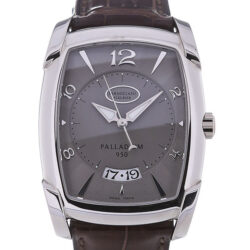 If you follow fashion trends in upscale, luxury watches, you’ve probably noticed the widespread use of Palladium. This soft, silvery metal closely resembles Platinum (“white gold”) in appearance.
If you follow fashion trends in upscale, luxury watches, you’ve probably noticed the widespread use of Palladium. This soft, silvery metal closely resembles Platinum (“white gold”) in appearance.
Today, it contributes significantly to alluring, high quality wristwatches.
An Unusual Element
As a metal, “Pd” offers some intriguing properties, qualities that likely contributed to the difficulty of working with it in jewelry during earlier centuries. Mining companies extract this rare “noble metal” element today primarily from mines located in South Africa and Russia, although less extensive deposits do occur in the United States and Canada. It frequently appears in combination with Gold and Platinum, a metal it closely resembles.
Palladium contains some very interesting physical characteristics. Although not known to harm humans who come into contact with it, this metal (pronounced “paladium”) reportedly combines with hydrogen gas more readily than some elements. When ground into a fine powder, it ignites. It won’t react with most strong acids at normal room temperature, but will do so when brought into contact with certain heated acids. Today, this unusual material performs important roles as a useful alloy in fine jewelry and as an industrial catalyst.
Stylish Upscale Timepieces
The sleek, silvery-white sheen of this element renders it increasingly popular as an alternative to Platinum. The English scientist, Dr. William Hyde Wollaston first distinguished it as a unique metal apart from Platinum in 1803. Impressed with its beauty and hardness, he named Palladium after the recently discovered asteroid Pallas, a heavenly object detected during the previous year.
Marketed today in luxury items as “Palladium” or “paladium”, this shiny metal gives a distinctive, beautiful quality to metallic surfaces. It has rapidly gained popularity in the fashion industry as a component of high quality jewelry, watches, and accessories due to its hardness and attractive, scratch-resistant properties. When you wear a wristwatch covered in this distinctive alloy, you won’t need to worry that exposure to an active lifestyle will leave scratches or dents on the surface easily.
Great Utility
Upscale watch makers have discovered several advantages in the use of Palladium. It will retain a shiny luster, even under environmental conditions in which Gold or Platinum grow slightly dull. For this reason, some manufacturers use this material as a component in watch cases and, sometimes, dials and other moving parts. It works very well for customers who easily experience allergies wearing some other metals, too.
Typical examples of the use of this lovely metal alloy appear in fine time pieces from Cartier, Tiffany and Vacheron Constantin. The ability to retain a vibrant exterior contributes to the overall quality of designer timepieces comprised of this silvery-white metal. Some specific brands include:




Purchasing a New Pd Watch
When buying a watch composed of this rare alloy, careful product research can prevent disappointment. As a luxury item, a wristwatch also offers a very utilitarian purpose. Swiss manufacturers in particular have developed fame for creating durable, in-demand products using this attractive noble metal.
Some types of customers in particular benefit by selecting a silvery-white lustrous Pd watch. These individuals include:
- People prone to metal allergies;
- Sports enthusiasts maintaining an active outdoor lifestyle;
- Designer wear enthusiasts;
- Watch collectors seeking representative name brands;
With many attractive designs available on the marketplace today, watches containing components made from Palladium continue to appeal to shoppers around the world.





